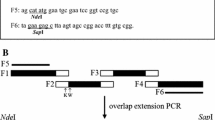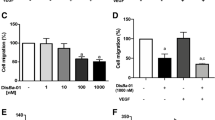Abstract
The integrin αvβ3 is involved in multiple aspects of malignant cancer, including tumor angiogenesis and metastasis, which makes the receptor a key target for the development of anti-cancer therapies. We report here on the production, the characterization and the in vivo anti-angiogenic and anti-metastatic properties of a novel αvβ3-binding disintegrin, DisBa-01, isolated from a cDNA library made with RNAs from the venom gland of Bothrops alternatus. The 11,637 Da-recombinant monomeric form of DisBa-01 displayed an RGD motif and interacted with purified αvβ3 integrin in surface plasmon resonance studies, in a dose-dependent and cation sensitive manner. A three-dimensional molecular model of DisBa-01 in complex with αvβ3 predicted a large surface of contacts with the β3 subunit. DisBa-01 inhibited the adhesion of αvβ3-expressing human microvascular endothelial cell line-1 (HMEC-1) and murine melanoma cell line B16F10 to vitronectin (IC50 = 555 nM and 225 nM, respectively), and transiently inhibited their proliferation without direct cell toxicity, but did not affect the binding nor the proliferation of a human breast cancer-derived cell line (MDA-MB-231) not expressing αvβ3. In vivo, DisBa-01 dose-dependently decreased bFGF-induced angiogenesis in a matrigel plug assay in athymic nude mice (IC50 = 83 nM). When injected intravenously to C57BL/6 mice together with B16F10 melanoma cells, DisBa-01 time- and dose-dependently inhibited lung metastasis monitored by bioluminescent imaging. We conclude that DisBa-01 is a potent new inhibitor of αvβ3-dependent adherence mechanisms involved in neo-vascularization and tumor metastasis processes.







Similar content being viewed by others
Abbreviations
- BFGF:
-
Basic fibroblast growth factor
- ECM:
-
Extracellular matrix
- FBS:
-
Foetal bovine serum
- FITC:
-
Fluorescein isothiocyanate
- GFP:
-
Green fluorescent protein
- HMEC-1:
-
Human microvascular endothelial cell line-1
- IPTG:
-
Isopropyl thio-β-d-galactopyranoside
- MD:
-
Molecular dynamics
- MIDAS:
-
Metal-ion-dependent adhesion site
- MS:
-
Mass spectroscopy
- PCR:
-
Polymerase chain reaction
- PDB:
-
Protein data base
- RGD:
-
Arginine-glycine-aspartic acid
- RU:
-
Resonance units
- SVMP:
-
Snake venom metalloproteinase
- Vn:
-
Vitronectin
References
Felding-Habermann B (2003) Integrin adhesion receptors in tumor metastasis. Clin Exp Metastasis 20:203–213
Fidler IJ (1975) Biological behavior of malignant melanoma cells correlated to their survival in vivo. Cancer Res 35:218–224
Albelda SM, Mette SA, Elder DE et al (1990) Integrin distribution in malignant melanoma: association of the beta 3 subunit with tumor progression. Cancer Res 50:6757–6764
Brooks PC, Clark RA, Cheresh DA (1994) Requirement of vascular integrin alpha v beta 3 for angiogenesis. Science 264:569–571
Enenstein J, Waleh NS, Kramer RH (1992) Basic FGF and TGF-beta differentially modulate integrin expression of human microvascular endothelial cells. Exp Cell Res 203:499–503
Voura EB, Ramjeesingh RA, Montgomery AM, Siu CH (2001) Involvement of integrin alpha(v)beta(3) and cell adhesion molecule L1 in transendothelial migration of melanoma cells. Mol Biol Cell 12:2699–2710
Cooper CR, Chay CH, Pienta KJ (2002) The role of alpha(v)beta(3) in prostate cancer progression. Neoplasia 4:191–194
Hersey P, Sosman J, O’Day S, et al A phase II, randomized, open-label study evaluating the antitumor activity of MEDI-522, a humanized monoclonal antibody directed against the human alpha v beta 3 (avb3) integrin, ± dacarbazine (DTIC) in patients with metastatic melanoma (MM). 2005 ASCO Annual Meeting Proceedings: Journal of Clinical Oncology; 2005
Soszka T, Knudsen KA, Beviglia L, Rossi C, Poggi A, Niewiarowski S (1991) Inhibition of murine melanoma cell-matrix adhesion and experimental metastasis by albolabrin, an RGD-containing peptide isolated from the venom of Trimeresurus albolabris. Exp Cell Res 196:6–12
Trikha M, De Clerck YA, Markland FS (1994) Contortrostatin, a snake venom disintegrin, inhibits beta 1 integrin-mediated human metastatic melanoma cell adhesion and blocks experimental metastasis. Cancer Res 54:4993–4998
Golubkov V, Hawes D, Markland FS (2003) Anti-angiogenic activity of contortrostatin, a disintegrin from Agkistrodon contortrix contortrix snake venom. Angiogenesis 6:213–224
Kang IC, Lee YD, Kim DS (1999) A novel disintegrin salmosin inhibits tumor angiogenesis. Cancer Res 59:3754–3760
Kim SI, Kim KS, Kim HS et al (2003) Inhibitory effect of the salmosin gene transferred by cationic liposomes on the progression of B16BL6 tumors. Cancer Res 63:6458–6462
Yeh CH, Peng HC, Huang TF (1998) Accutin, a new disintegrin, inhibits angiogenesis in vitro and in vivo by acting as integrin alphavbeta3 antagonist and inducing apoptosis. Blood 92:3268–3276
Yeh CH, Peng HC, Yang RS, Huang TF (2001) Rhodostomin, a snake venom disintegrin, inhibits angiogenesis elicited by basic fibroblast growth factor and suppresses tumor growth by a selective alpha(v)beta(3) blockade of endothelial cells. Mol Pharmacol 59:1333–1342
McLane MA, Sanchez EE, Wong A, Paquette-Straub C, Perez JC (2004) Disintegrins. Curr Drug Targets Cardiovasc Haematol Disord 4:327–355
Gould RJ, Polokoff MA, Friedman PA et al (1990) Disintegrins: a family of integrin inhibitory proteins from viper venoms. Proc Soc Exp Biol Med 195:168–171
Sali A, Blundell TL (1993) Comparative protein modelling by satisfaction of spatial restraints. J Mol Biol 234:779–815
Fujii Y, Okuda D, Fujimoto Z, Horii K, Morita T, Mizuno H (2003) Crystal structure of trimestatin, a disintegrin containing a cell adhesion recognition motif RGD. J Mol Biol 332:1115–1122
Senn H, Klaus W (1993) The nuclear magnetic resonance solution structure of flavoridin, an antagonist of the platelet GP IIb-IIIa receptor. J Mol Biol 232:907–925
Laskowski RA, MacArthur MW, Moss DS, Thornton JM (1993) PROCHECK: a program to check the stereochemical quality of protein structures. J Appl Cryst 26:283–291
Bowie JU, Luthy R, Eisenberg D (1991) A method to identify protein sequences that fold into a known three-dimensional structure. Science 253:164–170
Vriend G (1990) WHAT IF: a molecular modeling and drug design program. J Mol Graph 8:52–56, 29
Lee JO, Rieu P, Arnaout MA, Liddington R (1995) Crystal structure of the A domain from the alpha subunit of integrin CR3 (CD11b/CD18). Cell 80:631–638
Xiong JP, Stehle T, Zhang R et al (2002) Crystal structure of the extracellular segment of integrin alpha Vbeta3 in complex with an Arg-Gly-Asp ligand. Science 296:151–155
Yahalom D, Wittelsberger A, Mierke DF, Rosenblatt M, Alexander JM, Chorev M (2002) Identification of the principal binding site for RGD-containing ligands in the alpha(V)beta(3) integrin: a photoaffinity cross-linking study. Biochemistry 41:8321–8331
van der Spoel D, Lindahl E, Hess B et al (2005) Gromacs User Manual version 3.3
Tsodikov OV, Record MT Jr, Sergeev YV (2002) Novel computer program for fast exact calculation of accessible and molecular surface areas and average surface curvature. J Comput Chem 23:600–609
Eliceiri BP, Cheresh DA (1999) The role of alphav integrins during angiogenesis: insights into potential mechanisms of action and clinical development. J Clin Invest 103:1227–1230
Takagi J, Kamata T, Meredith J, Puzon-McLaughlin W, Takada Y (1997) Changing ligand specificities of alphavbeta1 and alphavbeta3 integrins by swapping a short diverse sequence of the beta subunit. J Biol Chem 272:19794–19800
Ray S, Chattopadhyay N, Biswas N, Chatterjee A (1999) Regulatory molecules in tumor metastasis. J Environ Pathol Toxicol Oncol 18:251–259
Monleon D, Esteve V, Kovacs H, Calvete JJ, Celda B (2005) Conformation and concerted dynamics of the integrin-binding site and the C-terminal region of echistatin revealed by homonuclear NMR. Biochem J 387:57–66
Baker NA, Sept D, Joseph S, Holst MJ, McCammon JA (2001) Electrostatics of nanosystems: application to microtubules and the ribosome. Proc Natl Acad Sci USA 98:10037–10041
Felding-Habermann B, Habermann R, Saldivar E, Ruggeri ZM (1996) Role of beta3 integrins in melanoma cell adhesion to activated platelets under flow. J Biol Chem 271:5892–5900
Felding-Habermann B, Mueller BM, Romerdahl CA, Cheresh DA (1992) Involvement of integrin alpha V gene expression in human melanoma tumorigenicity. J Clin Invest 89:2018–2022
Hieken TJ, Farolan M, Ronan SG, Shilkaitis A, Wild L, Das Gupta TK (1996) Beta3 integrin expression in melanoma predicts subsequent metastasis. J Surg Res 63:169–173
Pilch J, Habermann R, Felding-Habermann B (2002) Unique ability of integrin alpha(v)beta 3 to support tumor cell arrest under dynamic flow conditions. J Biol Chem 277:21930–21938
Schneller M, Vuori K, Ruoslahti E (1997) Alphavbeta3 integrin associates with activated insulin and PDGFbeta receptors and potentiates the biological activity of PDGF. EMBO J 16:5600–5607
Sung V, Stubbs JT 3rd, Fisher L, Aaron AD, Thompson EW (1998) Bone sialoprotein supports breast cancer cell adhesion proliferation and migration through differential usage of the alpha(v)beta3 and alpha(v)beta5 integrins. J Cell Physiol 176:482–494
Brooks PC, Montgomery AM, Rosenfeld M et al (1994) Integrin alpha v beta 3 antagonists promote tumor regression by inducing apoptosis of angiogenic blood vessels. Cell 79:1157–1164
Dimmeler S, Zeiher AM (2000) Endothelial cell apoptosis in angiogenesis and vessel regression. Circ Res 87:434–439
Plopper GE, McNamee HP, Dike LE, Bojanowski K, Ingber DE (1995) Convergence of integrin and growth factor receptor signaling pathways within the focal adhesion complex. Mol Biol Cell 6:1349–1365
Harms JF, Welch DR, Samant RS et al (2004) A small molecule antagonist of the alpha(v)beta3 integrin suppresses MDA-MB-435 skeletal metastasis. Clin Exp Metastasis 21:119–128
Shannon KE, Keene JL, Settle SL et al (2004) Anti-metastatic properties of RGD-peptidomimetic agents S137 and S247. Clin Exp Metastasis 21:129–138
Kauskot A, Cominetti M, Ramos O et al (2007) A novel recombinant RGD-disintegrin from Bothrops alternatus (DisBa-01) antagonizes alphaIIb beta3 and inhibits thrombosis. XXIst Congress of the International Society on Thrombosis and Haemostasis. Blackwell, Geneva
Nurden AT, Nurden P (2003) GPIIb/IIIa antagonists and other anti-integrins. Semin Vasc Med 3:123–130
McLane MA, Kuchar MA, Brando C, Santoli D, Paquette-Straub CA, Miele ME (2001) New insights on disintegrin-receptor interactions: eristostatin and melanoma cells. Haemostasis 31:177–182
Acknowledgments
The authors wish to thank Dr Marika Pla and Martine Chopin, Département d’Expérimentation Animale, IFR 105 -Saint Louis-Institut Universitaire d’Hématologie, Paris, France, for their skillful management of animal care facilities, and Monique Etienne from SMBH, Bobigny, France, for histological work. MRC and OHPR were the recipient of research grants provided by FAPESP (Fundação de Amparo à Pesquisa do Estado de São Paulo). This work was supported by travel grants provided in cooperation by INSERM and the Brazilian government (CNPq-INSERM collaboration), a Marie Curie European Reintegration Grant (Project MERG-CT-2004-006377) and grants from the Association pour la Recherche sur le Cancer (Project ARC-7801 and Pôle ARECA) and from the Canceropole Ile-de-France.
Author information
Authors and Affiliations
Corresponding author
Additional information
Oscar H. P. Ramos and Alexandre Kauskot contributed equally to this work.
Rights and permissions
About this article
Cite this article
Ramos, O.H.P., Kauskot, A., Cominetti, M.R. et al. A novel αvβ3-blocking disintegrin containing the RGD motive, DisBa-01, inhibits bFGF-induced angiogenesis and melanoma metastasis. Clin Exp Metastasis 25, 53–64 (2008). https://doi.org/10.1007/s10585-007-9101-y
Received:
Accepted:
Published:
Issue Date:
DOI: https://doi.org/10.1007/s10585-007-9101-y




